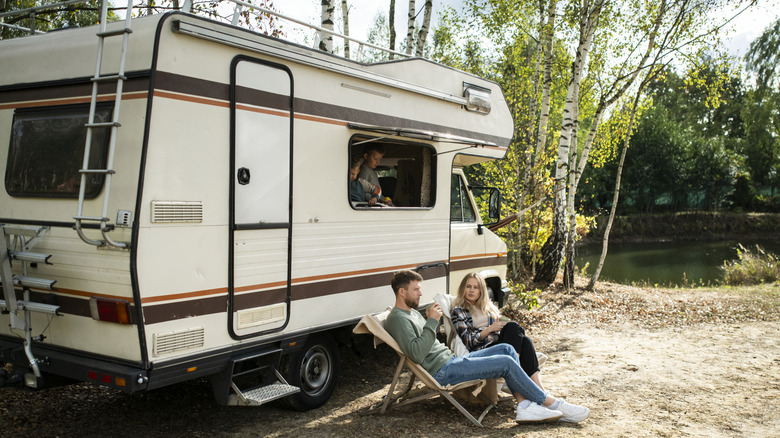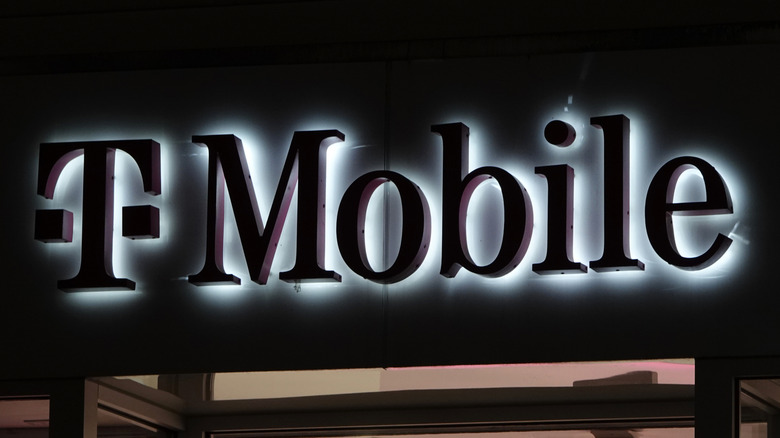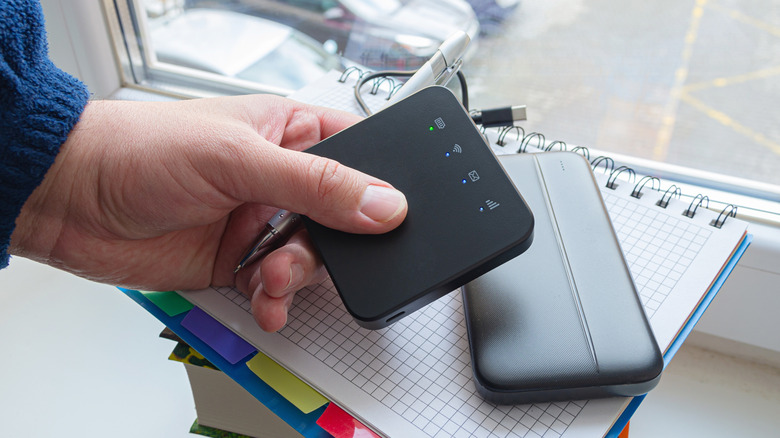4 Of The Best Internet Service Options For RVs
When you're looking to live the RV life or become a digital nomad, there is one important question you need to answer — how to connect to the internet. Taking to the open road and enjoying some peace and quiet away from cities and towns is fantastic, but eventually, you'll need to get online, whether it's to work or get in contact with family and friends.
However, you can't get a normal internet plan and have it work wherever you're going. Cable internet requires you to be grounded so you can plug the cable in, and with an RV, it's unlikely you'll be staying in one place for long. And while RV parks may have Wi-Fi available, it may not be the best quality.
For those who need reliable internet on the road, satellite internet is generally a good option. You'll get your signal from a satellite relay, forgoing the need for cables — though these providers tend to be pricier. Cellular internet (whether via a mobile hotspot or a cellular modem) is also a valid option, though you'll need to ensure proper cell tower coverage wherever you go. We've looked into a variety of internet providers meant to provide service to those on the road, and based our picks on prices, useability, and reviews. A full explanation of our methodology is listed below.
Starlink Roam
Starlink might be the most well-known satellite internet option, and there's a good reason for that — it provides internet accessibility in places that don't traditionally have a connection. Starlink Roam's basic plan is only $50 a month and gives you 50GB of data, and if you happen to hit that limit, you can pay by the GB. You can also opt out of the additional GB fees and have that 50GB be a hard limit, effectively cutting you off from internet access once you reach the data cap.
The basic plan is great for those who don't plan on going online or streaming content often. It's also a good plan for those who only use Starlink as a supplementary service and rely on public and RV park Wi-Fi for most of their internet needs. If you need unlimited data, Starlink Roam's unlimited plan is $165 a month. This data is not only available countrywide, but it's also available internationally if you take your travels beyond the border. But regardless of which Roam plan you choose, you can pause and unpause it as needed. So, if you're done with your RV trip or are staying somewhere with stable internet for a while, you can save by not paying for a service you're not using.
There is one catch to Starlink, however — the cost of the relay. All satellite internet will require some additional hardware to get up and running, but Starlink's options are especially expensive. You get two relay options: The standard kit for $349 or the Mini kit for $599. Both are useable with Starlink Roam, but the Mini can be easier to store, and that's important when in an RV with limited space. Whether it's worth the cost is ultimately up to you.
TravlFi
As its name suggests, TravlFi is an internet provider that caters to RVers first and foremost. Interestingly enough, TravlFi does not use satellite internet for its service; instead, it uses cellular internet to keep people connected. The company isn't limited to one cellular tower network, either, as TravlFi can connect most of the networks that big carriers use. This means you'll still have coverage, even in more remote areas.
TravlFi doesn't follow the same pricing schemes as mobile hotspots, either. You can sign up for either 4G or 5G internet options, but the unlimited data plans are the same price at $129 a month. The main advantage of the 4G option is the lower cost, starting at just $19 a month for 2GB of data.
Regardless of whether you go the 4G or 5G route, you will need to buy one of TravlFi's routers to use their service, and they're not exactly cheap. The JourneyXTR 4G Router is $329, and the XTR Pro 5G Router is $549, which is getting close to Starlink's more expensive hardware option. In addition, even if you have the 5G plan, you wouldn't be able to use it if you bought the 4G router. This means you need to decide which plan you want to sign up for before buying it so you don't waste time or money on a return.
T-Mobile Away
T-Mobile's Away Wi-Fi plans are in an interesting spot compared to services like TravlFi. The company has expanded its Home Internet service over time, and these data plans are an offshoot of this service. So that means the Away plans are not connected to a mobile hotspot. While the internet is still from T-Mobile's 5G cellular network, there are fewer limits on data or device connections over mobile hotspots.
T-Mobile has two plans for this service: A 150GB plan for $110 a month, and unlimited data for $160 a month. Unlike most other services, you don't need to pay extra for the hardware needed to set up the internet, either. You'll even get T-Mobile's latest iteration of Price Lock, which will lock the price of how much you pay for 5G internet (for the data plan you chose) until you choose another plan or leave T-Mobile.
The only catch to watch out for is that T-Mobile, unsurprisingly, only uses its cellular tower network for connections, so you'll want to look at the 5G coverage map and make sure you're not planning to travel to any dead zones.
SpeedFusion Travel
Peplink's SpeedFusion Travel is unique compared to the competition. However, there is something important to note about the company — Peplink generally caters to those with technical know-how. Many of the options beyond SpeedFusion lean more toward enterprise services, so much of the site (including those consumer areas) is created with IT professionals in mind instead of an average home internet user. But those willing to wade through Peplink's obtuse site can find a powerful RV internet solution.
What makes SpeedFusion Travel stand out is the amount of control you have over your connection. With the Peplink App, you can easily see your internet's health, connect to different SpeedFusion Connect cloud locations, and even prioritize which apps get network traffic. SpeedFusion Travel needs a Peplink eSIM data plan to use, and there are a lot of options to sift through. For most RVers, a choice from the NA & EU single-device plans will work. These prepaid plans have only a bit of eSIM data — 20GB, 30GB, and 60GB, respectively — but they also offer ten times the amount of SpeedFusion Connect data, which is a big boost for those on the road a lot. These data plans also last a year, so you don't need to pay by month for data.
It's also important to mention that Peplink technically has another travel internet-oriented solution called SpeedFusion Relay. The issue is that the SFC-RLY product prominently displayed on Peplink's site is discontinued, though this is not mentioned on the main Relay page.
What about mobile hotspots?
Mobile hotspots can be another solution for RVers, but they have some distinct disadvantages compared to satellite internet. The main problem comes to coverage — mobile hotspots, unlike a service like TravlFi, will tend to only be able to connect to one network's cellular towers, which can lead to dead service spots and is not ideal.
The main advantage of mobile hotspots is their convenience. Many carriers offer mobile hotspot packages, whether you add it to your current phone plan or get a separate package. In addition, you have more places to use a mobile hotspot than satellite internet, as the satellite needs little to no interference with the signal to work correctly. If you have a power supply, you can use your mobile hotspot — provided you're not in one of the aforementioned dead zones.
Verizon, AT&T, and T-Mobile all offer mobile hotspot packages, which you can purchase separately. Some carriers, such as Google Fi, include mobile hotspot services as part of their phone plans. At the end of the day, though, the best service for you will be the one that works wherever you may end up, so there's no one-size-fits-all recommendation.
Methodology
To determine the best RV internet services, we looked into providers that cater to those on the road, or those living in rural areas, where reliable cable internet is harder to obtain. From there, we determined which are suitable for travel and compared prices, data plans, and how easy it is to set up in an RV specifically. We also looked at user reviews to ensure that the services offered by each plan work well and are accurate to its marketing.






